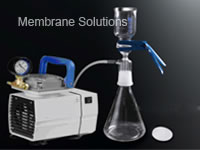In scientific research and various industrial applications, purity is paramount. Whether for chemical analysis, pharmaceutical production, or laboratory experimentation, the quality of solvents can significantly impact the accuracy of results and the safety of processes. Solvent filtration has emerged as an essential process in ensuring the purity of solvents by removing unwanted particulates, impurities, and contaminants. This article will explore the importance, types, and applications of solvent filtration in various scientific and industrial fields.

What is Solvent Filtration?
Solvent filtration is a purification process that removes impurities from solvents, typically through the use of specialized filters designed to capture particulates or organic and inorganic contaminants. By providing a high level of purity, solvent filtration helps prevent unwanted reactions, enhances analytical accuracy, and protects sensitive laboratory equipment from damage. It’s a process widely applied in chemistry labs, pharmaceutical production, environmental testing, and many other sectors where the reliability of results is crucial.
Types of Filters Used in Solvent Filtration
Depending on the level of filtration needed and the type of solvent, several filters and filtration systems are available for solvent purification. The most commonly used include:
Membrane Filters: These filters are highly effective for capturing fine particulates and are available in various pore sizes, allowing users to customize filtration to specific purity requirements. Membrane filters are often made of materials like polytetrafluoroethylene (PTFE), polyethersulfone (PES), and polyvinylidene fluoride (PVDF) to ensure compatibility with different solvent types, from aqueous solutions to organic solvents.
Depth Filters: Built to capture large quantities of particulates, depth filters are designed for high-volume filtration where heavier or larger particles need to be removed. They often serve as pre-filters in a series of filtration steps, capturing coarser impurities to extend the lifespan of finer membrane filters downstream.
Activated Carbon Filters: Used for removing organic impurities and adsorbing contaminants, activated carbon filters are beneficial in applications where solvents may contain unwanted organic compounds that can interfere with downstream processes or analyses.
Vacuum Filtration Systems: Often employed for laboratory-scale filtration, vacuum filtration uses a membrane filter combined with a vacuum pump to draw the solvent through the filter, enabling faster filtration rates. These systems are especially useful for processing small to medium volumes of solvent in a short time.
Applications of Solvent Filtration
Solvent filtration is indispensable in several fields, including:
Pharmaceutical Production: Purity is critical in pharmaceuticals, as any contaminant in solvents can lead to adverse reactions or compromised drug quality. Solvent filtration ensures that solvents used in drug synthesis and formulation are free from impurities, thus safeguarding product safety and efficacy.
Analytical Chemistry: In techniques like high-performance liquid chromatography (HPLC) and gas chromatography (GC), solvent quality directly affects analytical accuracy. Filtration helps to eliminate particulates and impurities that could clog columns or interfere with readings, leading to more consistent and reliable results.
Environmental Testing: Solvent filtration is essential for environmental labs that test for pollutants in air, water, and soil samples. By removing contaminants from solvents, filtration ensures that only target analytes are detected, reducing the risk of false positives or skewed results.
Cosmetic and Food Industries: In the production of cosmetics and food products, solvents are often used to extract or dissolve ingredients. Solvent filtration ensures that these solvents remain uncontaminated, safeguarding product quality and consumer safety.
Benefits of Solvent Filtration
Solvent filtration offers several advantages in both research and industrial settings:
· Enhanced Accuracy: By ensuring that solvents are free of impurities, solvent filtration improves the accuracy and reproducibility of analytical and research results.
· Equipment Protection: Filters prevent particulates and contaminants from damaging sensitive laboratory equipment, reducing maintenance costs and downtime.
· Safety: Filtration helps to remove hazardous impurities, making solvents safer to handle and use, particularly in processes involving reactive or volatile chemicals.
· Consistency and Quality Control: Filtration ensures consistency in solvent quality, which is essential for processes requiring stringent quality control, such as pharmaceutical manufacturing.
The Future of Solvent Filtration
As analytical techniques and industrial processes evolve, the demand for highly specialized and efficient solvent filtration systems is rising. Innovations in filtration technology, such as nanofiber filters, automated filtration systems, and sustainable filtration materials, promise to enhance the speed, efficiency, and environmental footprint of solvent filtration. These advancements are likely to broaden the application range of solvent filtration across emerging fields, including biotechnology, environmental monitoring, and green chemistry.
Conclusion
Solvent filtration is a critical process in many scientific and industrial applications, ensuring purity, safety, and reliability. Whether in a pharmaceutical lab or a large-scale industrial setting, solvent filtration is essential for achieving precise, consistent, and safe results. As filtration technology advances, we can expect even greater enhancements in solvent purity and process efficiency, supporting the scientific and industrial advancements of tomorrow.
Solvent filtration stands as a key pillar of quality and accuracy, helping us reach new levels of precision in science and industry.




评论 (0)